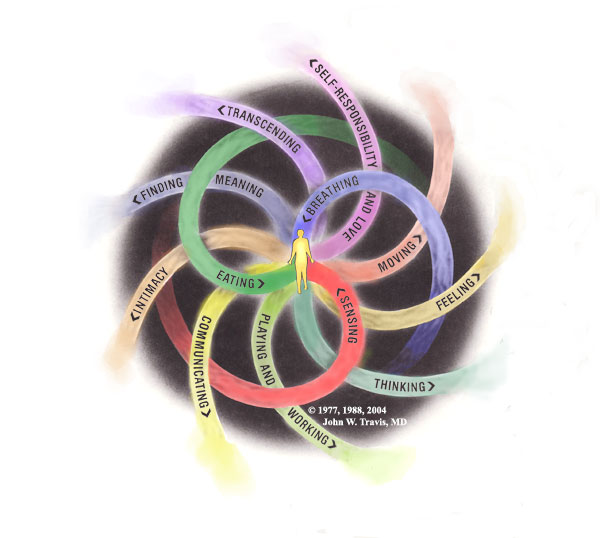Illness and Energy
When the flow of energy in your system is balanced and smooth, you feel good. When there is interference in the flow, illness is often the result. Interference can occur at any point. It could be due to:
- low quality or insufficient input energy - such as polluted air or a poorly balanced diet
- an insufficient or weak transformer - such as a damaged heart or an overweight body
- blockages to output energy - such as the inability to express emotions or no one with whom to communicate.
The challenge of being well, then, is the challenge of maximizing the efficiency of your energy transformation system.

The Wellness Energy System has twelve components - three are the major sources of energy input: eating, breathing, and sensing; and nine are forms of energy output: self-responsibility and love, moving, feeling, communicating, thinking, sex, working and playing, finding meaning, and transcending.*
Although our body essentially knows what it needs, both in quantity and quality, we often give it much more or much less. We have been trained over a lifetime to listen to the demands of our mind rather than the pleas of our body; we seek immediate comfort rather than allowing the time and supplying the resources that will help our body heal or realign itself. The media has convinced us that we need more, more, more; bigger, fancier and better; or somehow different. We don’t. Regardless of what we have been led to believe, we do not need a whole shelf full of vitamins, minerals, and other assorted supplements to be healthier (although most people's diets do require some supplementation of minerals and vitamins). We do not need an expensive array of exercise equipment or a wardrobe of workout clothes and special shoes. We do not need a membership in a gym or health club, even though these facilities can be beneficial. We do not need a personal trainer or a live-in masseuse and beautician. Nor do we need a degree in nutrition and microbiology to keep ourselves well. As we will illustrate, good health is as simple as choosing to take a full, energizing, and relaxing breath, right now. Inhale... exhale... ahhh.
To be “simply well” is to honor the simple basics of life, to appreciate the raw essentials of what it means to be human, to acknowledge honestly what we must do to foster who we really are, with a minimum of overlays. When we aren’t lost in the “stuff” of health (or anything else), we can listen to ourselves (body, mind, and soul are “speaking” to us all the time) about what we genuinely want and need. We can “listen” to the many cues and clues that our surroundings have for us (through the words of other people, through the way events turn out, through what we see or hear) without being overwhelmed; taking and using what is worthwhile to us, while discarding the rest without strings attached. Furthermore, as we get back in touch with ourselves in the simple and basic ways suggested here, we find that we are not so different from others. Recognizing our interdependence, we set the stage for true compassion and genuine service to others. We are encouraged, when we rest in simple awareness and simple wellbeing, to view birth, growth, and creativity, along with weakness, illness, and death as normal aspects of life’s unfolding mystery.
Simply Well is structured around thirty-two life-affirming topics, each one inviting you to make healthier choices for yourself. The choices are simple, but not all easy, and will require thought and effort. If you’ve spent twenty, forty, or sixty years establishing a group of habits, any one of which is draining your life-force, it will likely take loving yet firm and consistent effort to turn yourself around. Use this information to begin or continue your exploration into the realm of healthier choices. Most of our “choices” in the area of health are better termed “reactions” since they are propelled by practices passed to us from our parents and family members, media hype, genetic heritage, and many other factors that influence us - generally unconsciously. Simply Well encourages greater self-awareness or consciousness - helping us break through the usual mechanical response to life. Breaking through, we catch a glimpse of how much more simple, spontaneous, and enjoyable life can be.
*Adapted from Travis, J., and Ryan, R.,
Wellness Workbook. First developed by John Travis in 1977, the Wellness Energy System is the theoretical framework for both this text and the
Wellness Workbook. For more details, see
this page.


